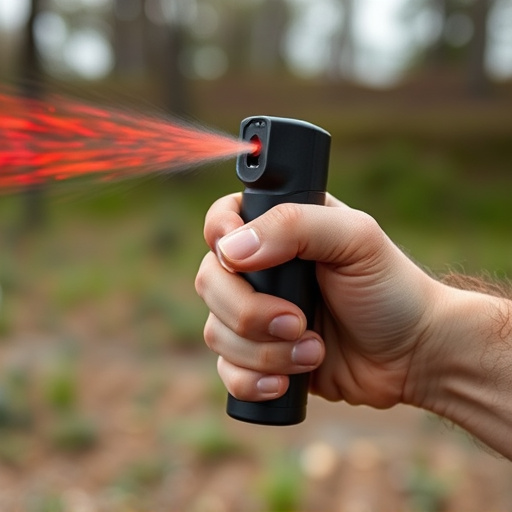Pepper spray, a powerful non-lethal deterrent, temporarily disables threats by targeting vision and breathing. Effective use requires understanding and practicing the pepper spray eye washing procedure—a 15-minute cool water flush to alleviate irritation. Legal awareness and accessibility are crucial for responsible self-defense preparation, ensuring safety in unexpected incidents.
“Personal security is a paramount concern in today’s world, prompting the exploration of effective non-lethal deterrent devices. This comprehensive guide delves into the intricacies of such tools, with a specific focus on pepper spray and its role as a powerful yet safe personal defense mechanism.
We’ll explore the science behind pepper spray, its effectiveness against potential threats, and crucial safety measures. Additionally, this article provides an in-depth look at eye washing procedures, essential legal considerations, and ensuring access to these life-saving tools. Prepare to discover a practical approach to safeguarding yourself.”
- Understanding Non-Lethal Deterrent Devices: A Comprehensive Overview
- The Role of Pepper Spray in Personal Security: Effectiveness and Safety
- Step-by-Step Eye Washing Procedure: Protecting Yourself After Exposure
- Legal Considerations and Accessibility: Ensuring Your Rights and Readiness
Understanding Non-Lethal Deterrent Devices: A Comprehensive Overview
Non-lethal deterrent devices, often referred to as personal security tools, are designed to incapacitate or deter potential threats without causing permanent harm. These devices offer individuals a sense of safety and empowerment in various situations, from everyday self-defense to law enforcement operations. One of the most common types is pepper spray, which temporarily blinds and irritates the eyes and respiratory system of the target, allowing the user to escape or disable the assailant.
The eye-washing procedure, an essential component of using pepper spray safely, involves quickly irrigating the affected area with water to minimize discomfort and irritation. It’s crucial to understand that these devices are intended for personal protection and should be used as a last resort when facing imminent danger. Proper training and awareness are vital to ensure effective and responsible usage, making non-lethal deterrents a valuable asset in maintaining personal security.
The Role of Pepper Spray in Personal Security: Effectiveness and Safety
Pepper spray has established itself as a popular and effective non-lethal deterrent for personal security. When deployed, it creates a temporary yet intense irritant that disrupts an assailant’s vision and breathing, providing crucial time for escape or help to arrive. The primary active ingredient, capsaicin, is derived from chili peppers, making it a natural yet potent substance. Unlike other chemical agents, pepper spray is designed to cause minimal harm while incapacitating the attacker temporarily.
However, it’s essential to understand that proper use and safety precautions are paramount. The Pepper Spray Eye Washing Procedure is a critical aspect of this; it involves quickly washing the affected area with water to dilute the spray and alleviate discomfort or potential long-term damage. Training in the correct procedure ensures individuals know how to respond if exposed to pepper spray, whether accidentally or as a security measure. This simple yet effective step underscores the importance of preparation and awareness in personal safety measures.
Step-by-Step Eye Washing Procedure: Protecting Yourself After Exposure
In the event of exposure to pepper spray, a quick and effective eye-washing procedure is essential for personal security and to mitigate the effects of the irritant. Here’s a step-by-step guide using a pepper spray eye washing procedure. First, immediately seek fresh air by moving to an open area if possible. Then, wash your face with cool water from a safe distance to prevent further spraying or contact. Hold your eyes closed tightly while pouring a steady stream of clean, cool water over the affected areas for at least 15 minutes. This step is crucial to flush out any remaining pepper spray particles. Afterward, gently pat your eyes dry using a soft, clean cloth or tissue. Remember, time is critical during this process; acting promptly can significantly ease discomfort and prevent long-term irritation.
For added protection, consider using eye protection gear while in situations where pepper spray exposure is a risk. These devices are designed to create a physical barrier between your eyes and potential irritants. Following the proper eye washing procedure ensures that you’re prepared for any unexpected encounters with non-lethal deterrents like pepper spray, allowing you to maintain control of your safety in various environments.
Legal Considerations and Accessibility: Ensuring Your Rights and Readiness
When considering a non-lethal deterrent for personal security, such as pepper spray, it’s crucial to understand the legal landscape surrounding its use in your region. Different jurisdictions have varying laws and regulations regarding the possession and application of pepper spray, so knowing your rights and responsibilities is essential. Consult local legislation to ensure you’re acting within the law when carrying and using such a device.
Accessibility plays a significant role in your preparedness. Ensure that you can easily gain control of and deploy your chosen deterrent promptly during an unexpected security incident. Familiarize yourself with the eye-washing procedure, especially if pepper spray is involved, as it’s crucial for mitigating potential harm after use. Being ready to defend yourself not only involves understanding the legal framework but also ensuring you have the means to protect yourself effectively and responsibly.
Non-lethal deterrent devices, such as pepper spray, offer individuals an effective means of personal security. Understanding their proper usage, including a simple eye washing procedure, is crucial for ensuring safety and legal readiness. By being prepared and informed, folks can navigate potential threats with confidence, knowing they have the tools to defend themselves while adhering to legal considerations.
